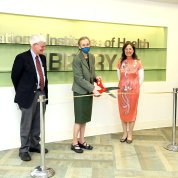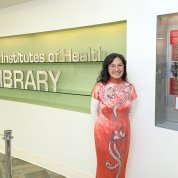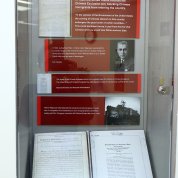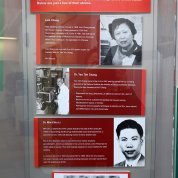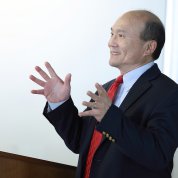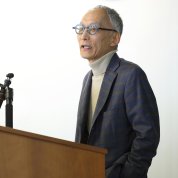Display in CC Commemorates Anniversary of Chinese Exclusion Act’s Repeal

Photo: Chia-Chi Charlie Chang
A new display at the NIH Library commemorates the 80th anniversary of the repeal of the Chinese Exclusion Act, which banned Chinese laborers from entering the United States.
“The repeal of the Chinese Exclusion Act was a really important event for science in the United States,” said Dr. Michael Gottesman, senior investigator at the National Cancer Institute (NCI) and former NIH deputy director for intramural research, during the display’s opening ceremony. “Our scientific workforce depends on the incredible contributions of tens of thousands of Chinese scientists.”
Chinese workers first began to immigrate during the California Gold Rush, said Devon Valera, acting senior curator in the Office of NIH History and Stetten Museum (ONHM), who conducted research for the display. Anti-Chinese sentiment rose among other workers as the number of Chinese laborers increased.
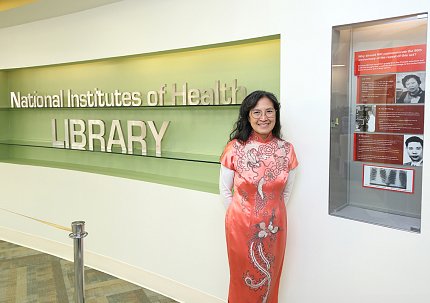
Photo: Chia-Chi Charlie Chang
In 1882, Congress passed the Chinese Exclusion Act—the first federal law that denied entry of a specific ethnic group. The legislation placed new requirements on people of Chinese descent already living here, ended the possibility of citizenship and made it difficult for them to return if they ever left. The act set a precedent for exclusionary immigration policies that targeted other Asian countries.
In 1943, Rep. Warren G. Magnuson—the legislator the Clinical Center is named after—proposed the Chinese Exclusion Repeal Act. It was signed into law by President Franklin D. Roosevelt.
Even though the act was repealed, Chinese immigration was still limited because of an ethnic quota system that favored European immigrants, said Valera. The system was in place until the Immigration Act of 1965 that removed race and ancestry as a basis for resettling here.
“The Chinese Exclusion Act is part of my family’s history,” said Susan Wong, chief scientific resources liaison with the Office of Research Services. “It resulted in the separation of my family in the early part of last century. The repeal allowed some of my family to reunite.”
Dr. Jake Liang was another beneficiary of the repeal of quota-based immigration laws. Soon after the policy reversals, his parents started talking about immigrating to the U.S. for a better life.
“My family ended up here in the mid-1970s,” said Liang, a distinguished investigator at the National Institute of Diabetes and Digestive and Kidney Diseases and chair of NIH’s Federation of Asian American, Native Hawaiian and Pacific Islander Network (FAN). “If it weren’t for the repeal, I most likely wouldn’t be here.”
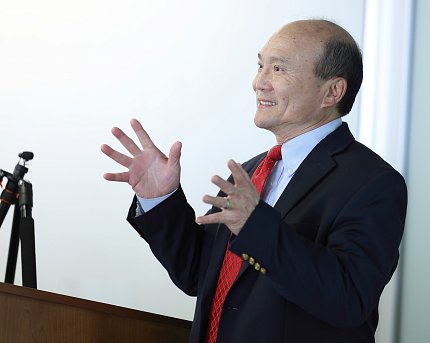
Photo: Chia-Chi Charlie Chang
After the act’s repeal, several fellows and other research trainees joined NIH components, including NCI and what’s now the National Institute of Arthritis and Musculoskeletal and Skin Diseases, said Michele Lyons, retired ONHM senior curator, who was instrumental in gathering objects and information for the display.
One of those scientists, Dr. Jacqueline Whang-Peng, became world renowned for her research on cytogenetics, or the study of chromosome inheritance. She was the first person to discover and confirm that cancer is related to chromosome variation. A display featuring Whang-Peng’s contributions to science can be found in the alcove near the pediatric clinic in Bldg. 10.
“I feel very proud to be part of a country that is not afraid to admit it made a colossal mistake,” said Dr. Nina Schor, NIH deputy director for intramural research. “There’s always someone, such as Congressman Magnuson, who has the courage to stand up and say, ‘we must reverse this. It’s not the right thing to do.’”
The display commemorating the anniversary of the repeal is located near the NIH Library’s entrance in Bldg. 10.
ONHM researched, wrote, designed and installed the display in-house, based on an idea by Wong. Contact ONHM at history@nih.gov for more information about the display, which is part of a rotating project that will be dismantled and replaced likely in late May, following AANHPI Heritage Month.
An agreement between ONHM and the NIH Library brings new stories and perspectives to the space about every six months.

